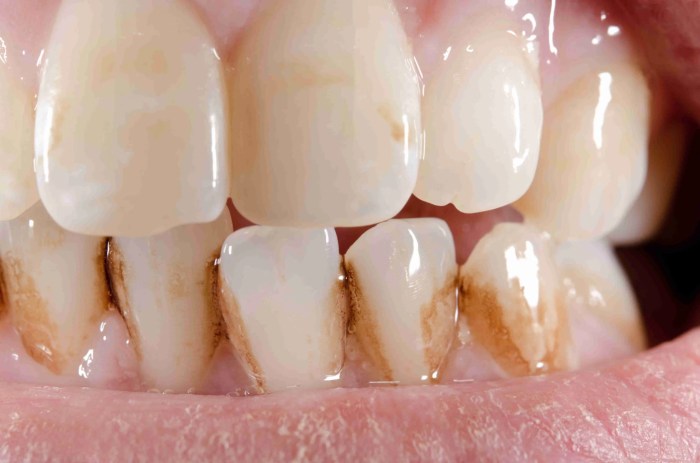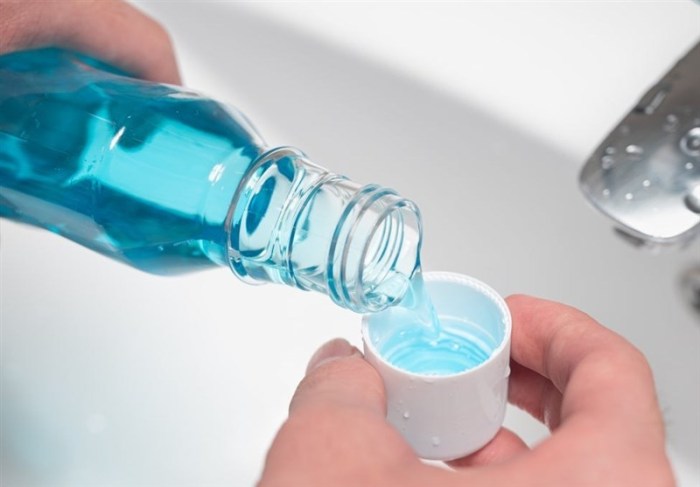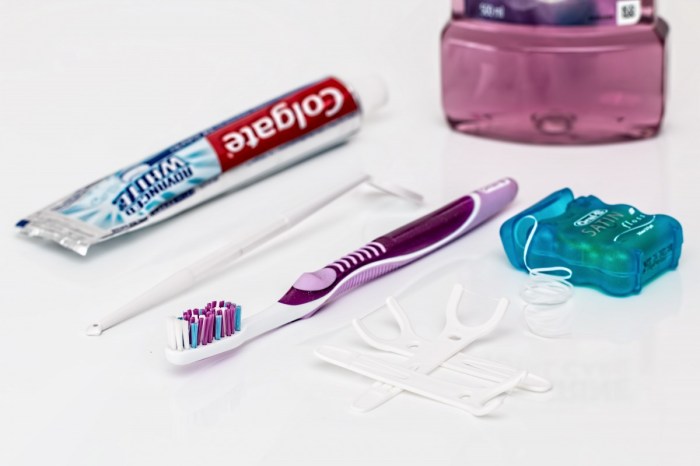Brown spots on teeth can be a frustrating aesthetic concern, but understanding their causes and treatment options can provide relief. This post delves into the various reasons behind these discolorations, from enamel defects to dental trauma, and explores effective diagnosis and treatment strategies, including at-home remedies and professional procedures.
From intrinsic staining, deeply rooted within the tooth structure, to extrinsic staining, often caused by dietary habits, we’ll unpack the different factors that contribute to brown spots. This includes a breakdown of the stages of tooth development and how they might affect the appearance of your teeth. We’ll also compare the visual characteristics of various causes, outlining potential treatment options and their effectiveness.
Causes of Brown Spots on Teeth

Brown spots on teeth can be a frustrating aesthetic concern, but understanding their causes is crucial for effective treatment. These discolorations can range from subtle to noticeable, and their origins can vary significantly. Addressing the root cause is vital for achieving a healthy and aesthetically pleasing smile.
Intrinsic Staining
Intrinsic staining refers to discoloration that originates within the tooth structure itself. This type of staining is often permanent and less easily treated than surface discoloration. The development of teeth involves intricate processes, and disruptions during these stages can lead to permanent staining.
- Enamel Hypoplasia: This is a common cause of intrinsic staining, resulting from a defect in enamel formation during tooth development. Enamel hypoplasia can manifest as small, irregular brown or white spots, sometimes appearing pitted or with a rough texture. These imperfections can be caused by various factors during childhood, including illness, malnutrition, or exposure to certain medications.
For example, a child experiencing prolonged illness with poor nutrition might experience enamel hypoplasia. Similarly, certain medications taken during tooth development can also lead to enamel defects.
- Dental Trauma: A direct blow to the tooth, a fracture, or a dental procedure can lead to intrinsic discoloration. This can manifest as brown or gray discoloration, potentially with a pitted appearance. The injury may disrupt the inner structures of the tooth, affecting its color. For instance, a sports injury to a child’s tooth could lead to internal discoloration that requires treatment.
- Developmental Factors: Factors like certain systemic diseases, infections, or medication use during tooth development can result in intrinsic discoloration. The exact mechanisms vary, but they often involve disruption of the tooth’s natural pigmentation or formation. For instance, a child diagnosed with a systemic illness that impacted their development might exhibit teeth with brown or gray discoloration.
Extrinsic Staining
Extrinsic staining is discoloration that occurs on the tooth surface, typically from external sources. This type of staining is often treatable and reversible. The staining agents can adhere to the enamel surface and cause discoloration.
- Foods and Drinks: Many common foods and drinks contain pigments that can stain teeth. Coffee, tea, red wine, berries, and certain types of sauces can contribute to surface staining and subsequent brown spots. For example, a daily intake of coffee can lead to a noticeable brown staining of the teeth.
- Poor Oral Hygiene: Insufficient brushing and flossing allow plaque and food particles to accumulate, leading to staining. Regular and thorough oral hygiene practices are crucial for preventing surface staining.
- Tobacco Use: Tobacco products are known to stain teeth, leading to a yellow or brown discoloration. The staining effect is typically pronounced, affecting teeth in noticeable ways.
Stages of Tooth Development
Understanding the stages of tooth development is essential for identifying the potential causes of brown spots. The formation of enamel begins in utero and continues through childhood. Disruptions at any stage can impact the final appearance of the teeth.
- Prenatal Stage: Nutritional deficiencies or illnesses during pregnancy can affect enamel formation in the developing teeth. The effects may be visible as brown spots later.
- Postnatal Stage: Factors such as illnesses, medications, and nutritional deficiencies during early childhood can also disrupt the enamel formation process, leading to brown spots.
Comparison of Common Causes
| Cause | Appearance | Treatment |
|---|---|---|
| Enamel Hypoplasia | Small, irregular brown or white spots, sometimes pitted | Fluoride treatments, bonding, veneers |
| Dental Trauma | Brown or gray discoloration, potentially with a pitted appearance | Dental bonding, crowns, root canal |
| Extrinsic Staining (Coffee/Tea) | Brown or yellowish staining on the tooth surface | Professional cleaning, teeth whitening |
Diagnosing Brown Spots
Pinpointing the exact cause of brown spots on your teeth is crucial for effective treatment. A thorough examination by a dentist, coupled with a comprehensive understanding of your medical history, is essential to determine the underlying issue and develop a personalized treatment plan. This process involves visual assessment, potentially utilizing diagnostic tools, and a careful consideration of your overall health.Identifying the specific characteristics of these discolorations helps dentists narrow down the possibilities.
Different causes manifest in distinct ways, leading to variations in the appearance of brown spots. For example, a brown spot caused by trauma might be localized and irregular in shape, while a spot from a dental procedure might appear more uniform. Accurate diagnosis ensures appropriate treatment, preventing unnecessary procedures and optimizing the outcome.
Those pesky brown spots on your teeth can be a real bummer, right? Sometimes, poor oral hygiene isn’t the only culprit. Did you know that certain types of sleep disorders, like types of sleep disorders , can also indirectly contribute to these stains? Stress and poor sleep quality can weaken the enamel, making it more susceptible to discoloration.
So, while brushing and flossing are crucial, looking at your overall health, including sleep patterns, might be a good idea too, when dealing with those stubborn brown spots.
Visual Characteristics of Brown Spots
Brown spots on teeth can vary significantly in size, shape, and location. Understanding these visual differences is vital in initial assessments. For instance, a small, isolated spot might indicate a localized issue like enamel erosion or a specific type of stain, while a larger, more diffuse discoloration could suggest deeper problems. Color variations within the spot itself, from a light brownish hue to a dark, almost black shade, also provide valuable clues.
The location of the spots, whether concentrated on a single tooth or spread across multiple teeth, can also offer insights into potential causes.
Diagnostic Procedures
Dentists employ various procedures to pinpoint the source of tooth discoloration. Initial visual inspection, often the first step, involves examining the color, size, shape, and location of the spots. This visual assessment allows dentists to quickly categorize the spots into potential categories and prioritize subsequent investigations. This early categorization helps streamline the diagnostic process and directs further inquiries.
Dealing with brown spots on your teeth can be frustrating. While I’m no dentist, I’ve heard that sometimes these spots can be a sign of underlying issues. Interestingly, similar to how fibroid pain is treated with various methods like medication and surgery, how fibroid pain is treated , different approaches can help address the root cause of these discoloration issues.
It’s essential to seek professional dental advice for a proper diagnosis and treatment plan for your specific brown spots.
Role of Medical History
A detailed medical history is an integral part of the diagnostic process. Information regarding previous dental work, medications, dietary habits, and any underlying medical conditions can significantly influence the diagnosis. For instance, certain medications, like tetracycline, can lead to specific tooth discoloration patterns. A patient’s history of trauma to the affected area can provide clues regarding the possible cause.
By considering the patient’s medical history, dentists can identify potential contributing factors and narrow down the list of possible causes.
Diagnostic Tools
| Diagnostic Tool | Function |
|---|---|
| Dental X-rays | Dental X-rays allow dentists to visualize the underlying structure of the tooth, revealing potential issues like cavities, cracks, or developmental problems that might be hidden beneath the surface and contributing to the discoloration. |
| Visual Inspection | A thorough visual examination enables dentists to assess the color, size, and shape of the spots, allowing for a preliminary classification of the type of discoloration. This aids in narrowing down the potential causes and directing further diagnostic steps. |
| Specialized Tests | In some cases, specialized tests like fluoride analyses or pulp tests may be necessary to confirm the diagnosis and explore underlying causes, such as cavities or infections. These tests help pinpoint the specific origin of the discoloration. |
Treatment Options for Brown Spots
Dealing with brown spots on your teeth can be frustrating, but the good news is that several effective treatment options exist. These range from relatively simple at-home remedies to more involved professional procedures. Understanding the pros and cons of each approach can help you make informed decisions about your dental care.Addressing brown spots requires careful consideration of their cause.
Some treatments might be more effective for certain types of discoloration, and professional evaluation is crucial to determine the best course of action.
At-Home Remedies
Some individuals explore at-home remedies for brown spots, though their effectiveness varies significantly. These often involve using whitening toothpastes or bleaching agents. While some individuals may experience slight improvements, these methods are generally less effective for substantial discoloration. Furthermore, prolonged or improper use of these remedies can potentially damage tooth enamel, leading to more serious issues in the long run.
Professional Dental Procedures
Professional dental procedures offer more reliable and targeted solutions for brown spots. These methods are typically recommended for significant discoloration that isn’t responsive to at-home remedies.
Dental Bonding
Dental bonding is a common and relatively affordable procedure for repairing minor imperfections and discoloration. A composite resin material is applied directly to the affected tooth, shaped, and hardened. This procedure is often used to fill small chips, cover minor gaps, or camouflage brown spots. The effectiveness of bonding depends on the extent of the discoloration and the skill of the dentist.
It’s a good option for addressing minor to moderate staining.
Veneers
Veneers are thin, custom-made shells that are bonded to the front of teeth. They are a more significant investment than bonding but can effectively conceal substantial discoloration, imperfections, and even slight misalignments. Veneers provide a noticeable improvement in aesthetics and can greatly enhance the appearance of teeth with brown spots. However, the procedure involves removing a small amount of enamel, and the cost is often higher.
Crowns
Crowns are typically used for more severe cases of tooth damage or extensive discoloration. They cover the entire visible portion of the tooth, providing a complete restoration. Crowns are durable and can last for many years, but the process of preparing the tooth for a crown often involves removing a significant amount of enamel. This option is often reserved for cases where other treatments are not sufficient, as it involves a more invasive procedure.
Preventive Measures
Prevention is always better than cure, and this holds true for brown spots on teeth. Maintaining good oral hygiene, including regular brushing and flossing, can help prevent the buildup of plaque and bacteria that contribute to discoloration. A balanced diet and avoiding staining agents, like certain beverages and foods, can also significantly reduce the likelihood of developing brown spots.
Routine dental checkups and cleanings are essential for early detection and intervention of potential issues.
Summary of Treatment Options
| Treatment | Cost | Success Rate | Description |
|---|---|---|---|
| Dental Bonding | Moderate | High (for minor to moderate staining) | Uses composite resin to repair minor imperfections and discoloration. |
| Veneers | High | High (for significant discoloration and imperfections) | Thin, custom-made shells bonded to the front of teeth. |
| Crowns | High | High (for extensive damage or discoloration) | Covers the entire visible portion of the tooth, providing a complete restoration. |
Prevention Strategies: Brown Spots On Teeth
Protecting your pearly whites from unsightly brown spots is largely about proactive habits. A comprehensive approach encompassing proper oral hygiene, a mindful diet, and consistent dental check-ups significantly minimizes the risk of discoloration. By understanding the contributing factors and adopting preventative measures, you can maintain a radiant, healthy smile for years to come.Maintaining a healthy smile is a continuous journey, not a destination.
Consistent effort in preventing stains and discoloration through good habits plays a crucial role in achieving long-term oral health. These preventive measures are vital in preserving the natural beauty of your teeth and preventing the need for more extensive and potentially more costly interventions later on.
Dealing with brown spots on teeth can be frustrating, especially when you’re trying to maintain a bright smile. Sometimes, the cause might be less about diet and more about the body’s recovery process, like after undergoing physical therapy for fracture hardware removal. This often involves intense physical therapy after fracture hardware removal, and the healing process can sometimes leave behind some subtle changes.
It’s important to remember that these changes, like those brown spots, are usually temporary and can be addressed by your dentist. Good oral hygiene and regular check-ups are key to maintaining a healthy smile, even after navigating the challenges of physical therapy. physical therapy after fracture hardware removal can have a surprising effect on your overall health, and it’s important to know what to expect.
Importance of Oral Hygiene
Oral hygiene is paramount in preventing brown spots and maintaining overall dental health. Regular brushing and flossing remove food particles, plaque, and bacteria that contribute to discoloration and tooth decay. Consistent removal of these substances helps maintain a healthy environment in your mouth, reducing the risk of stains forming and providing a strong foundation for a beautiful smile.
Effective Brushing Techniques
Proper brushing technique is essential for effectively removing plaque and food particles. Use a soft-bristled toothbrush and a fluoride toothpaste. Brush all tooth surfaces for two minutes, twice daily, using gentle, circular motions. Pay close attention to the gum line and the areas where teeth meet. Consider using an electric toothbrush for enhanced plaque removal.
Effective Flossing Techniques
Flossing is equally important for reaching the areas between your teeth where your toothbrush cannot effectively clean. Use about 18 inches of floss, wrap it around your middle fingers, and gently slide it between each tooth. Curve the floss around each tooth in a C-shape and move it up and down to remove plaque. Repeat this process for all the teeth.
Role of Diet in Preventing Tooth Discoloration
Your diet significantly impacts the color of your teeth. Certain foods and drinks contain pigments that can stain your teeth over time. By making informed dietary choices, you can minimize the risk of discoloration.
Foods and Drinks That Stain Teeth
- Dark-colored fruits and vegetables: Berries, beets, and carrots can stain teeth. Limit consumption or rinse your mouth with water after eating them.
- Coffee and tea: These beverages contain tannins that can stain teeth. Consider using a straw to minimize contact with your teeth. If possible, use a water-soluble coffee alternative. For tea, consider herbal varieties.
- Red wine: The tannins in red wine can leave a noticeable stain on your teeth. Limit consumption and rinse with water after drinking.
- Dark sodas: The acidity and pigments in these drinks can lead to tooth staining. Consume them in moderation and rinse with water afterwards.
- Certain fruits and vegetables: Fruits and vegetables like berries, beets, and carrots contain pigments that can stain teeth. Limit consumption or rinse your mouth with water after eating them.
Strategies to Minimize Staining Impact
- Rinsing with water: Immediately rinsing your mouth with water after consuming staining foods and drinks can help remove some of the pigments.
- Using a straw: When consuming staining drinks, using a straw can minimize contact between the drink and your teeth.
- Chewing sugar-free gum: Chewing sugar-free gum stimulates saliva production, which can help wash away food particles and neutralize acids.
- Brushing immediately after meals: Brushing your teeth immediately after eating or drinking staining substances can help remove the pigments before they have a chance to adhere to your teeth.
Comprehensive Guide to Preventing Tooth Staining
A comprehensive approach to preventing tooth staining involves both lifestyle choices and dental care habits. By combining a mindful diet, consistent oral hygiene practices, and regular dental check-ups, you can significantly reduce the risk of developing brown spots and maintain a healthy, radiant smile.
Potential Complications

Brown spots on your teeth, while sometimes aesthetically unappealing, can sometimes be a sign of deeper issues. Ignoring these spots can lead to more serious problems, requiring extensive dental work and potentially causing discomfort or pain. Understanding the potential complications is crucial for making informed decisions about your dental health.Untreated brown spots can create a cascade of problems, ranging from minor sensitivity to more severe conditions like tooth decay and even infection.
Early detection and intervention are key to preventing these complications and preserving the health and integrity of your teeth.
Enamel Erosion and Increased Sensitivity
Enamel erosion, a common cause of brown spots, weakens the protective outer layer of your teeth. This thinning of enamel makes the underlying dentin more exposed. This increased exposure leads to heightened sensitivity, making your teeth more vulnerable to pain from hot, cold, or sugary foods and drinks. Without intervention, this sensitivity can escalate, significantly impacting your ability to eat and drink comfortably.
Risk of Tooth Decay, Brown spots on teeth
The exposed dentin from enamel erosion is a prime location for bacteria to accumulate. This bacterial buildup can lead to the formation of cavities, or tooth decay. Cavities begin as small openings in the enamel and can progressively worsen, leading to pain, infection, and ultimately, the need for fillings, root canals, or even tooth extraction. Imagine a small crack in a wall that gradually widens, allowing moisture and debris to penetrate and damage the structure.
Pain and Discomfort
As enamel erosion progresses and cavities form, pain and discomfort become increasingly likely. Initially, you might experience mild sensitivity, but untreated spots can lead to throbbing pain, especially when exposed to temperature changes. In severe cases, persistent pain can significantly impact your quality of life.
Long-Term Effects of Neglect
Neglecting brown spots can have long-term consequences. Unresolved enamel erosion can lead to a cascade of problems. Consider the scenario of a car with a small dent that is ignored. Over time, the dent may become more pronounced and eventually affect the structural integrity of the car. Similarly, unattended brown spots can compromise the long-term health and functionality of your teeth.
Professional Intervention is Crucial
Regular dental checkups and cleanings are essential for early detection of enamel erosion and other dental issues. If you notice brown spots, don’t delay seeking professional dental intervention. A dentist can accurately diagnose the cause of the discoloration and recommend appropriate treatment options to prevent further complications. Prompt attention to these issues can prevent significant problems down the road.
Summary Table of Potential Complications
| Untreated Spot | Potential Complications |
|---|---|
| Enamel Erosion | Increased sensitivity, risk of decay, potential for pain, long-term structural damage |
| Cavities | Pain, infection, possible need for fillings, root canals, or tooth extraction |
Closing Summary
In conclusion, understanding the diverse causes, diagnosis, and treatment options for brown spots on teeth is crucial for maintaining a healthy and aesthetically pleasing smile. Preventing these spots through good oral hygiene and a balanced diet is key, and seeking professional dental care for effective treatment is always recommended. Remember, early intervention can prevent long-term complications and ensure the best possible outcome.




